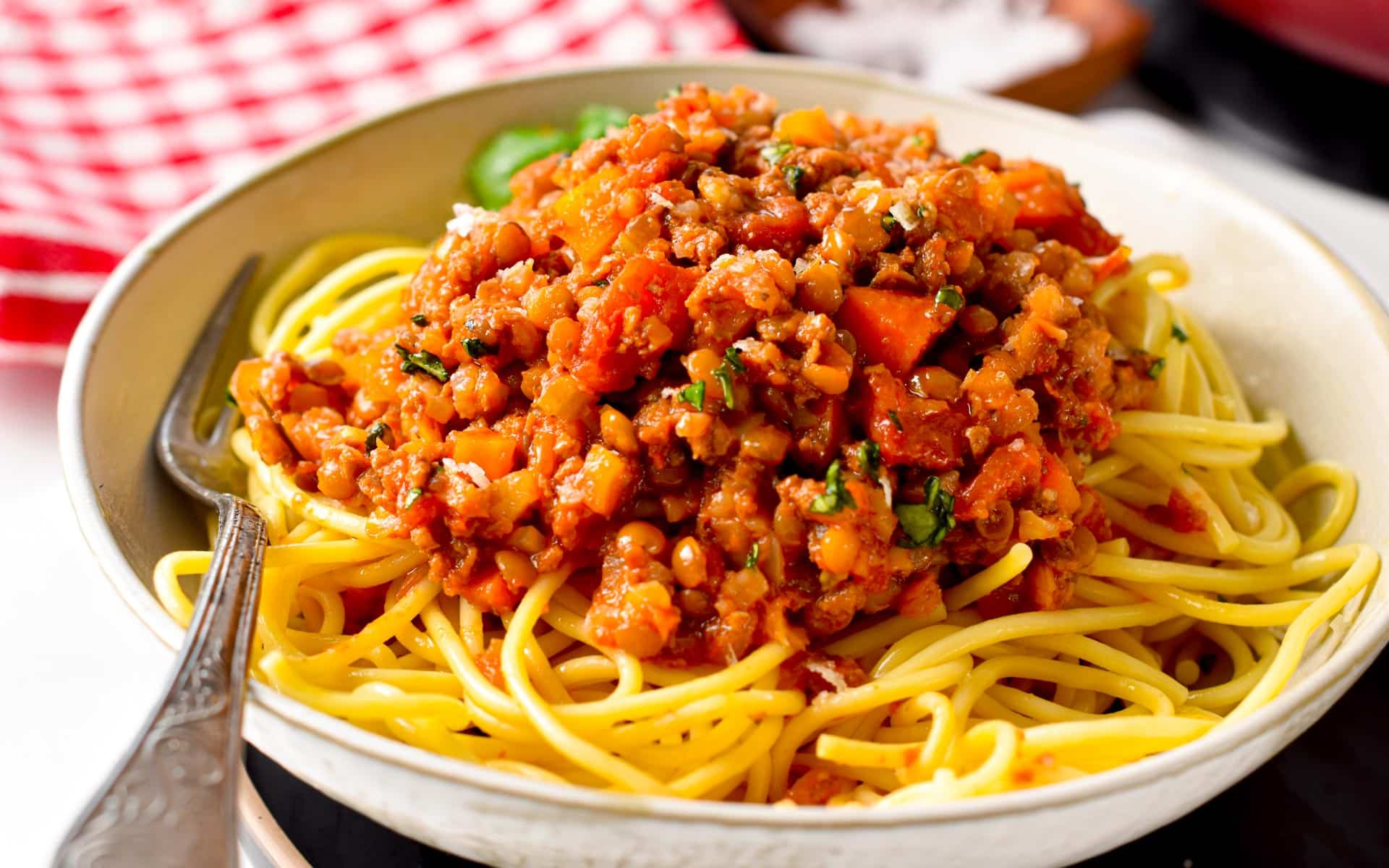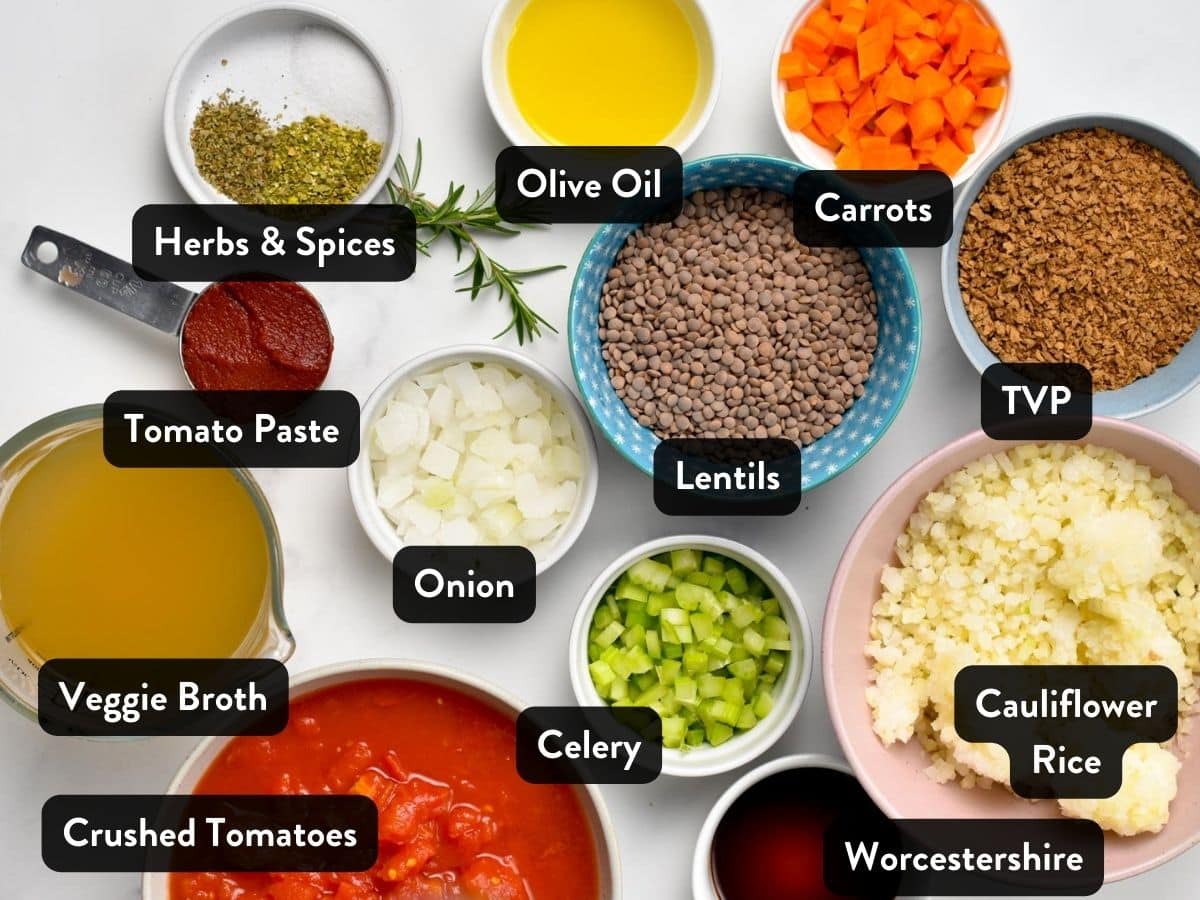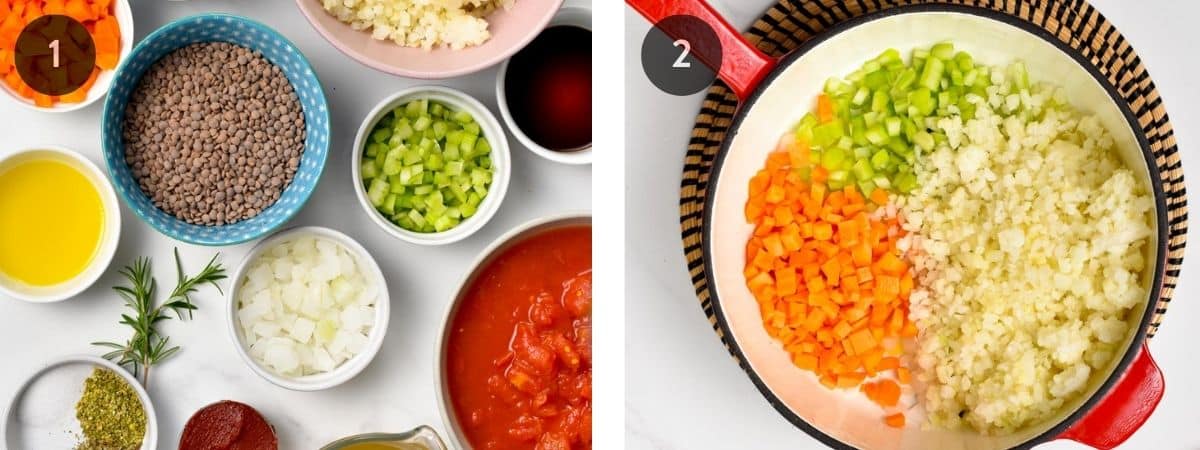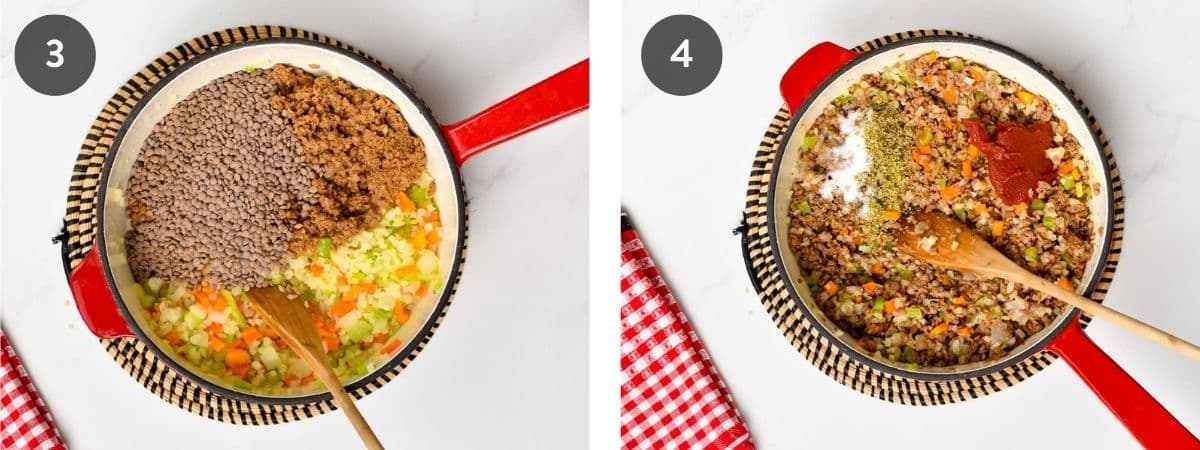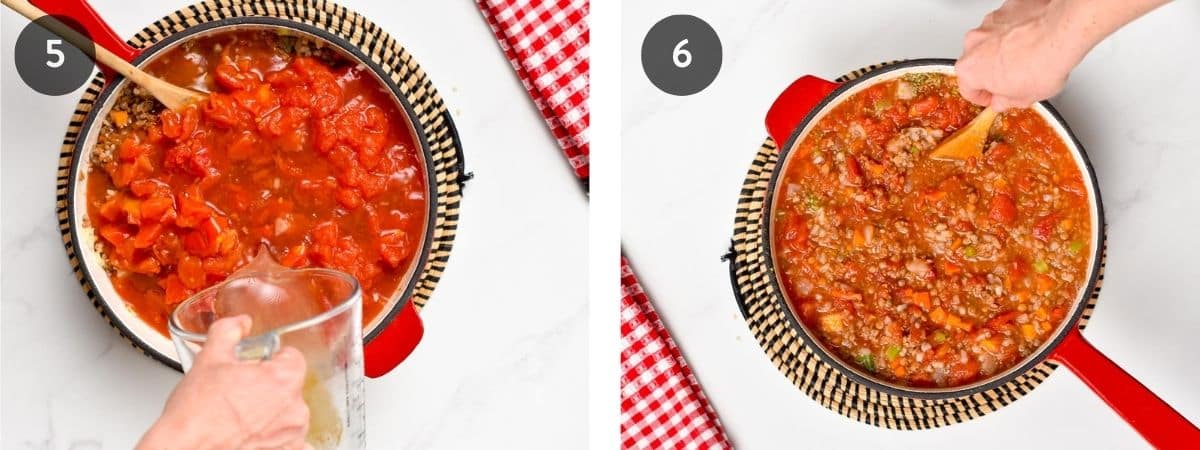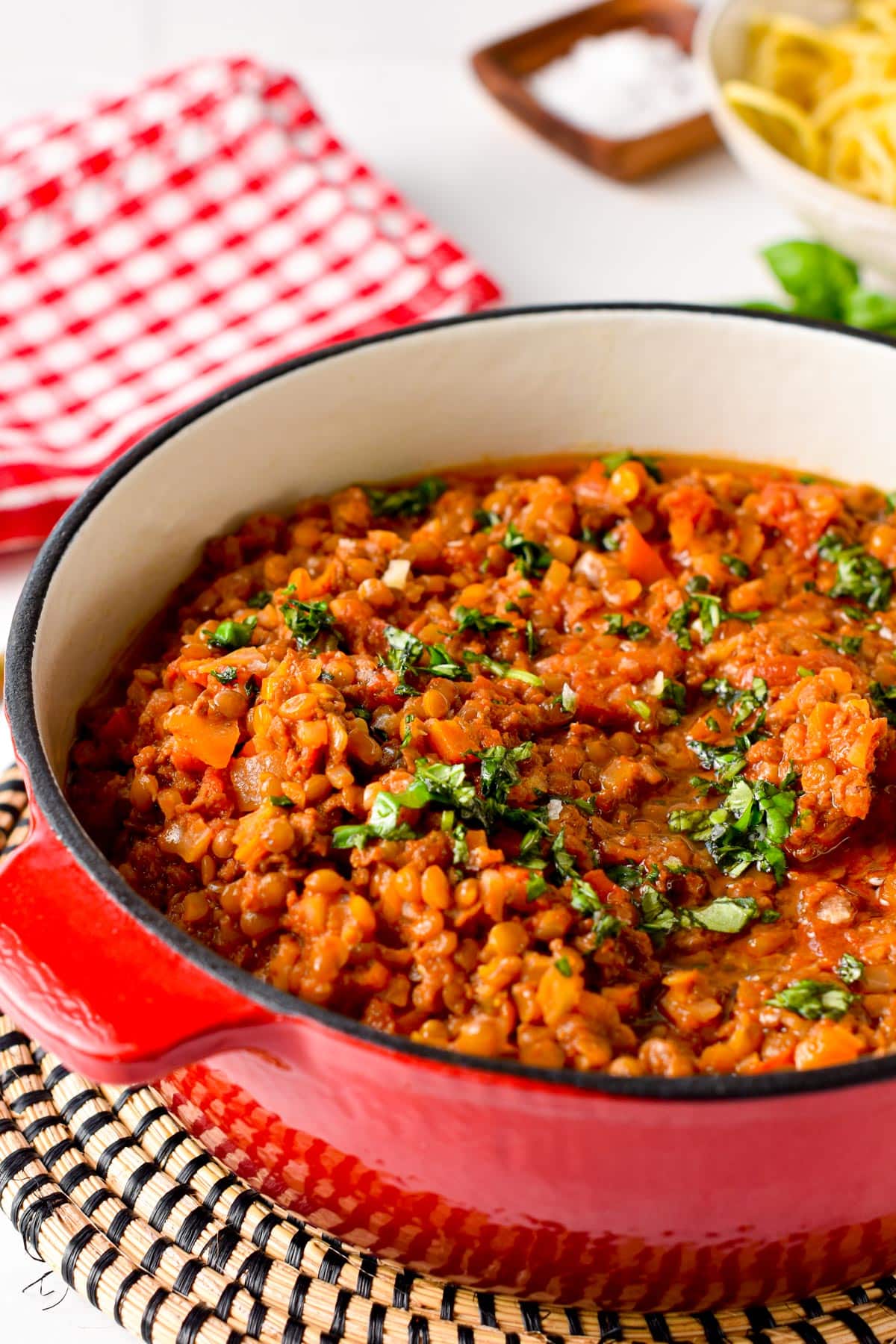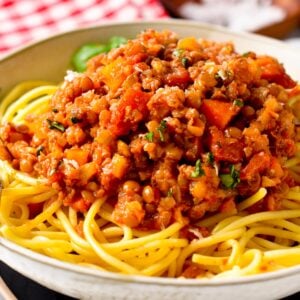I love making vegan versions of classic dishes like my Vegan Scalloped Potatoes, Vegan Creamy Mushroom Pasta, and Sweet Potato Black Bean Burger. The classic Bolognese recipe is a century-old Italian recipe that has seen many modifications over the years. Before going vegan, Damien used to make the classic recipe that was taking hours of simmering, and, interestingly, didn’t contain tomatoes at all!
What’s A Vegan Bolognese?
Bolognese is one of the oldest classic recipes that I used to make as an easy student dinner. In this vegan version, the meat is replaced by a combination of brown lentils, textured soy protein, and cauliflower rice. The combination of the three adds the protein and meat texture to the Bolognese sauce and it’s hard to believe it’s plant-based. This sauce can be used on spaghetti by also as a filling in lasagna. This recipe is one that I make almost every week for my spaghetti-loving family. I’ve also tried it many times with guests who couldn’t believe there was no meat! It’s a game-changer, crazy-easy dinner recipe!
Ingredients and Substitutions
Here are the ingredients you need to make a tasty vegan Bolognese sauce.
Olive Oil – pick locally-sourced extra-virgin olive oil. Onion – Finely chopped, fresh, or frozen. Garlic Cloves – You can also use garlic powder. Celery Sticks – finely diced or ground in a food processor. Carrots – Finely diced or ground in a food processor. Cauliflower Rice or broccoli rice. This is just cauliflower pulsed into a rice-like texture in a blender. You can buy ready-made cauliflower rice in the frozen aisle of most grocery stores. It’s cheaper and also easy to use frozen in any recipe to mimic ground meat texture and add greens to your day. Vegetable Broth – Or veggie stock. Textured Soy Protein or finely diced mushrooms. Both work great but for those who are not fans of button mushrooms, texture protein are a great alternative. I rehydrated textured soy protein for this recipe. I like the texture it adds to the Bolognese sauce but also, soy is a complete protein, so it adds all the essential amino acids you need on a vegan diet. Brown Lentils – Brown lentils are rich in protein and fiber. You can also use other lentil colors, but the ones that brings the best texture are brown lentils. Salt and Pepper – to taste. Dried Marjoram, Oregano, Fresh Rosemary Sprigs – Herbs are what brings all the Italian flavors to the sauce. Tomato Paste – Tomato paste is thicker and tastier than tomato passata. Vegan Worcestershire sauce or tamari sauce. This adds the umami flavor, meaty flavor, to the sauce. Crushed Canned Tomatoes – You can also use fresh tomatoes that you roast in the oven for 10 minutes and blend for a few seconds in a blender.
How To Make Vegan Bolognese
There are many ways to make a Bolognese recipe vegan using a different source of vegan proteins. But here I am sharing a veggie lentil Bolognese recipe that contains plants. It’s our specialty, the dish we make almost once a week and I can promise you everyone will love it!
Serving
There are two ways of serving a good vegan Bolognese. Feel free to pick the way you enjoy the most. Some people like to stir the cooked spaghetti pasta and Bolognese sauce together in the Dutch oven before serving. I prefer to serve the warm pasta on plates and top it with a good amount of warm Bolognese sauce. Stir in your plate to combine and serve with extra toppings for a boost of flavors. You can then serve it with some bread, like my:
2-Ingredient Bread Oat Flour Bread Irish Soda Bread Without Buttermilk
Topping Suggestions
The best ingredients to serve with vegan pasta are:
Vegan Parmesan Fresh Basil Fresh Parsley A drizzle of olive oil Ground Pepper and extra salt Red Pepper Flakes for a spicy flavor or cayenne pepper.
Storage Instructions
You can store the Bolognese sauce on its own or already stirred in the cooked spaghetti. Store in an airtight container in the fridge for up to 4 days. This is also a freezer-friendly meal. It can be kept for up to one month in the freezer, and it’s the perfect family-friendly dinner for kids on busy weekdays. Simply thaw the recipe in the fridge the day before serving. Rewarm in a large non-stick pan, add a bit of water at the bottom to loosen the sauce, and prevent the pasta from cooking in the pan.
Pro Tips for Easy Swaps
Below are some substitution ideas for you to try if you are allergic to some of the ingredients.
Gluten-Free – The Bolognese sauce in this recipe is entirely gluten-free. However, to serve gluten-free Bolognese, make sure you pick wheat-free pasta like quinoa spaghetti, rice noodles, or edamame spaghetti for a boost of proteins. Soy-Free – You can replace the textured soy proteins with more cauliflower rice, finely diced mushrooms, ground walnuts, or vegan meat alternatives like Beyond Meat. If so, stir-fry the vegan meat in a separate skillet before adding it to the sauce. This adds flavor and prevents the vegan meat from steaming in the sauce, which wouldn’t add much texture. Swap the soy sauce for vegan Worcestershire sauce. Oil-Free – You can stir-fry the vegetables with a tablespoon of water. However, the oil-free version makes the Bolognese very watery. A good old-fashioned Bolognese recipe is usually a bit oily. Low-Carb – Feel free to use low-carb pasta for this recipe, including homemade zucchini noodles, edamame noodles, and black bean noodles.
Find below are my answers to your most common questions about vegan pasta dinner recipes.
More Vegan Pasta Dinner Recipes
If you like this recipes, you’ll love these other easy vegan dinner recipes.
